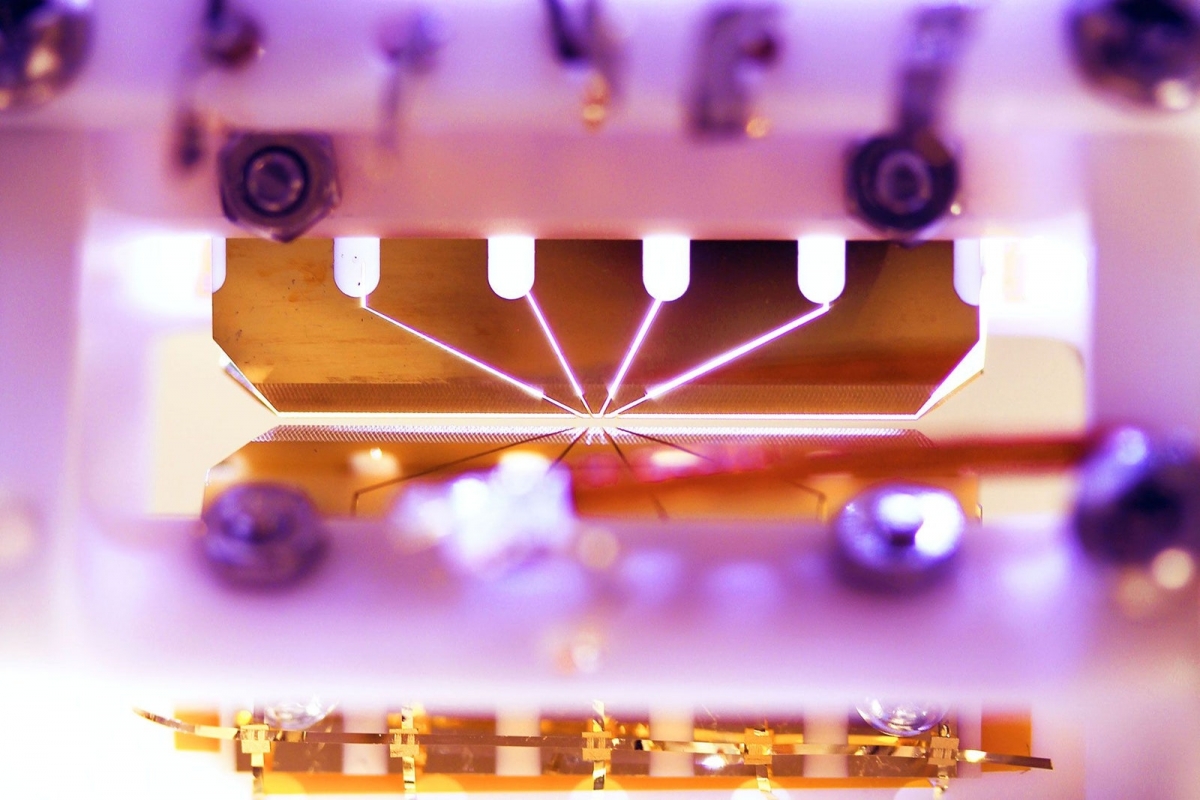
Picture of the trapped ion quantum computer that was used to demonstrate a new way to learn information about quantum experiments. (Credit: S. Debnath and E. Edwards/JQI)
A collaboration between researchers at JQI and North Carolina State University has developed a new method that uses a quantum computer to measure the thermodynamic properties of a system. The team shared the new approach in a paper published August 18, 2021, in the journal Science Advances.
“We’ve illustrated a new way to get at thermodynamic properties of a system, such as free energy, entropy, and other properties that are too complex to currently be measured via traditional or quantum computing,” says Lex Kemper, associate professor of physics at NC State and corresponding author of the paper. “By calculating partition function zeros, we are on the way to solving the problem of scaling to larger numbers of qubits when trying to calculate free energies and entropies in a given system.”
Partition functions are a mathematical way to represent the statistical properties of systems in equilibrium—properties like the total energy, free energy, entropy and pressure. In the new work, researchers used a small quantum computer to calculate where the partition function of a particular system dips to zero, allowing researchers to then derive other quantities of interest. This provides a new shortcut to getting these properties for quantum systems, and it supplies a new application for quantum devices that are generally still small and noisy.
Quantum computers are poised to be powerful tools for studying complex systems of many interacting particles. Their unique quantum abilities allow them to solve certain problems much more quickly than conventional computers. However, some problems, like describing thermal systems, are still too challenging even for quantum computers.
“Thermal systems are most of the systems we have to deal with in our lives,” says Daiwei Zhu, an author of the paper and a graduate student in physics at JQI. “Everything purely quantum only exists around the lowest possible temperatures or in a well isolated environment, which in our real world just doesn't exist. So basically, this technique enables us to actually prepare a quantum state that, if you look at it in a specific way, preserves all the behavior you would expect for its thermal properties.”
Those properties can be derived from the entropy, but calculating the entropy itself can be a challenge.
“Our method skips the part where we calculate the entropy in favor of looking at the partition function,” Kemper says. “That’s because the partition function is a generating function—a function that you can perform operations on to get at other thermodynamic information such as the internal energy and the entropy.
To demonstrate the new procedure, the researchers created a special quantum state of a spin model that represents a handful of mutually pushing and pulling quantum magnets changing over time. By varying a magnetic field and watching how the state changed, the team pieced together the partition function.
The researchers compared the partition function obtained using a trapped ion quantum computer in the laboratory of JQI Fellow Norbert Linke with results of theoretical simulations. Both results compared favorably.
“This new method utilizes many state of the art techniques in quantum computing in a very innovative way,” Zhu says. “I feel very excited about the insight this approach provides in studying thermal quantum states.”
The authors say that as hardware improves, their technique might be extended to study the thermodynamics of larger systems and provide researchers with an elegant way to simulate some messy physics.
The research appears in Science Advances and is supported by the Department of Energy (grant DE-SC0019469). First author of the paper Akhil Francis is a graduate student at NC State. Norbert Linke and Chris Monroe from the University of Maryland; Jim Freericks from Georgetown University; and Sonika Johri from IonQ also contributed to the work.
This story was originally published by North Carolina State. It has been adapted with permission here.